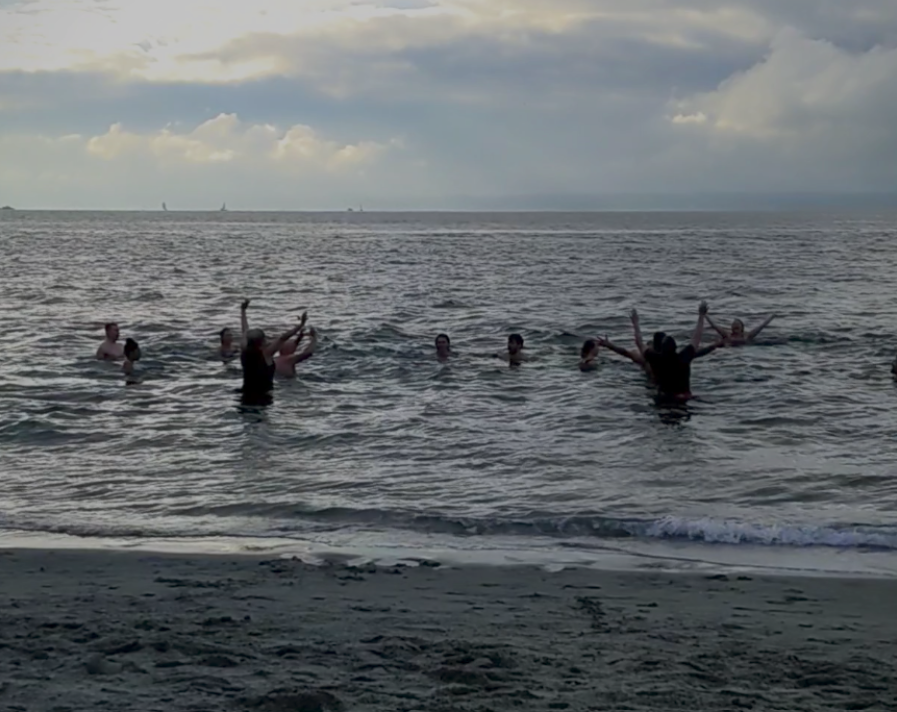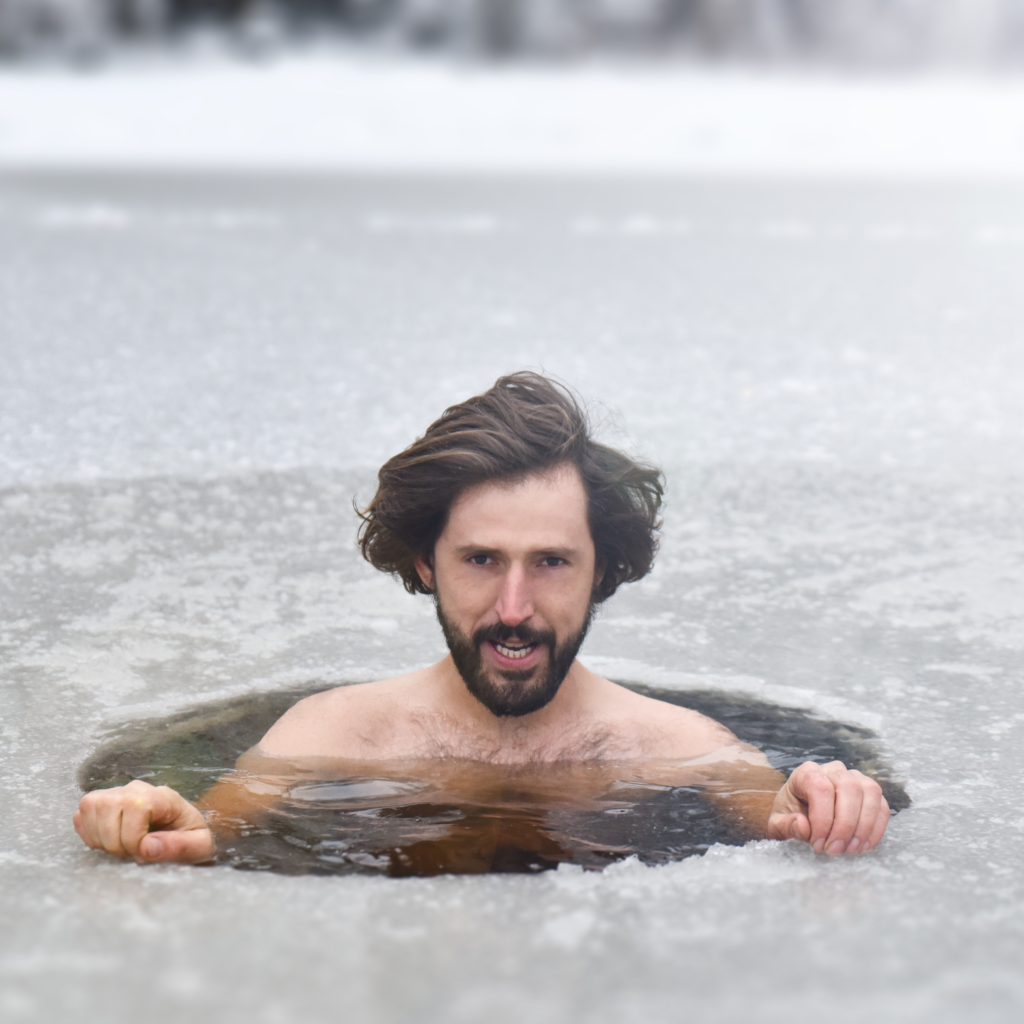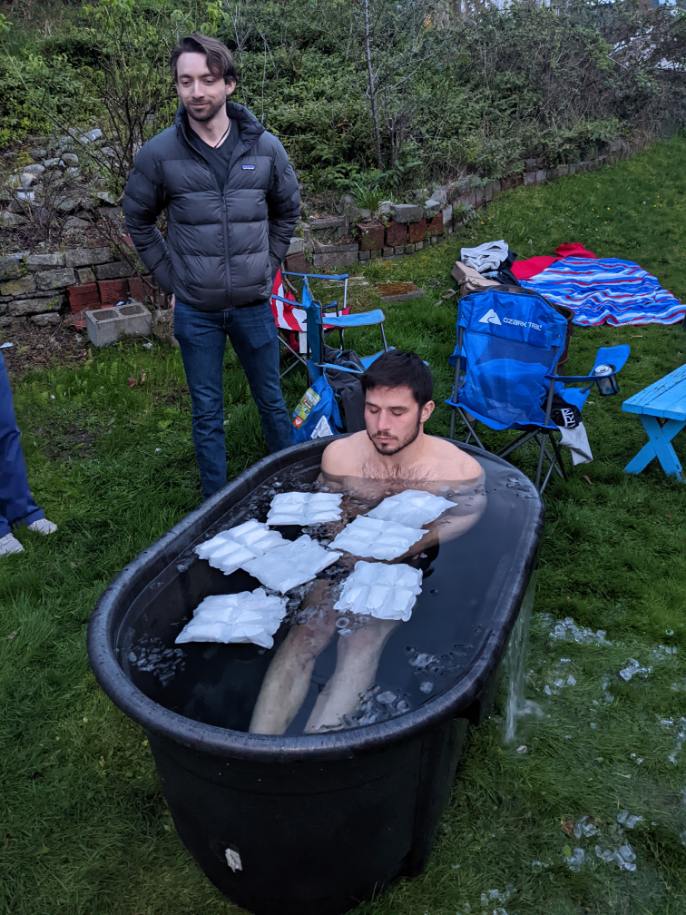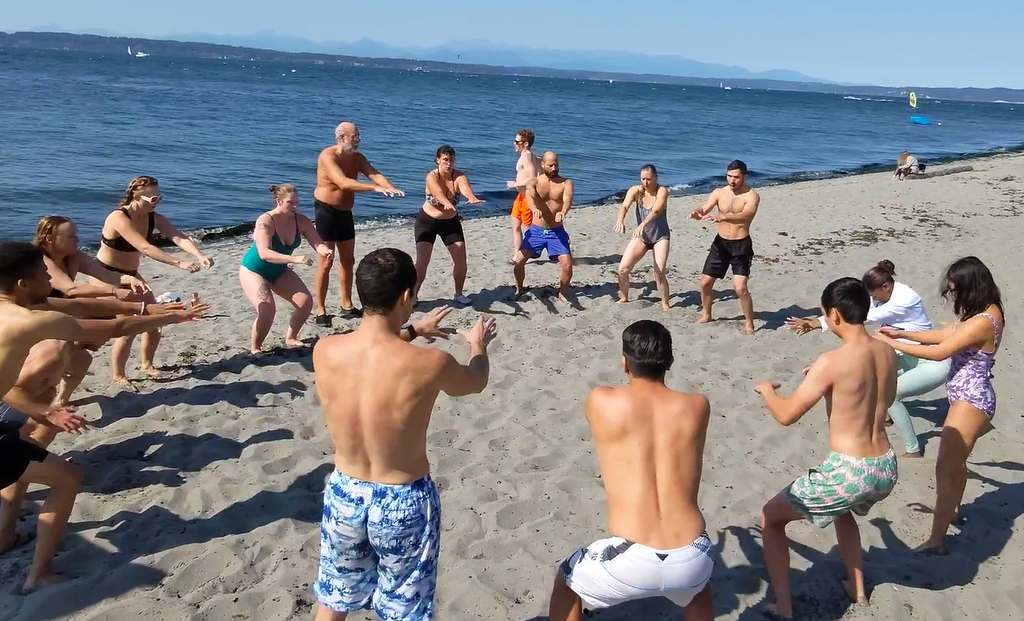
Table of contents:
Cold exposure, once seen as an unpleasant encounter, is gaining recognition as a potent practice with transformative benefits for both mental and physical health. In this comprehensive guide, we’ll dive into the captivating world of cold exposure, exploring its history, the science behind it, and the numerous advantages it offers. Whether you’re drawn to cold showers, ice baths, or simply curious about the remarkable effects of cold on your body, this article has something for everyone.
Thermogenesis is our natural mechanism for generating heat to maintain body warmth. Cold thermogenesis (deliberate cold exposure or cold therapy) is like turbocharging this process. When you subject yourself to colder environments, your body shifts into high gear to uphold homeostasis and regulate your core temperature. It increases energy production to stay toasty, resulting in the burning of calories to generate heat. As a result, your metabolism gets a boost. Furthermore, hormones responsible for regulating body temperature also contribute to the breakdown of heat-related fat, with actors like epinephrine, norepinephrine, and thyroid hormones playing key roles.
Ancient Traditions: Throughout history, diverse cultures have harnessed the power of cold water and ice for healing and spiritual growth. The ancient Greeks and Romans, for instance, embraced cold baths for their invigorating effects on the body and mind.
Nordic Tradition: Accustomed to icy landscapes, have embraced cold exposure for centuries. Practices like saunas and ice dips have been part of their culture, promoting vitality and resilience in challenging conditions.
Japan: The Japanese Misogi tradition is a Shinto practice for spiritual and physical purification. It involves standing beneath waterfalls during the colder months, with the belief that the cold water cleanses both the spirit and body while cultivating discipline and resilience.
Russia: In Russia, “Morzhevatelstvo,” or “Walrusing,” is a time-honored tradition. Enthusiasts, known as “Morzh” (Walrus), take icy dips even in the harshest winters, claiming it boosts vitality and immunity. Complementing this is the Russian Banya, where participants, after a hot steam bath, often plunge into snow or icy water.
Indigenous American Tribes: Numerous North American indigenous tribes practiced cold exposure. The Lakota Sioux, for instance, performed the Inipi ceremony using sweat lodges for purification, often concluding with participants jumping into cold streams to complete their purification ritual.
Tummo Tibetan Traditions: also known as ” the fire within” or “psychic heat,” is a traditional Tibetan practice of generating intense body heat through advanced meditation techniques and breath control. Practitioners of Tummo can raise their core body temperature, allowing them to endure extreme cold and promote physical and mental well-being. This ancient practice has been a source of fascination has of late.
Modern Resurgence: In recent years, the resurgence of cold exposure practices owes much to pioneers like Mr. W. Hof, known as “The Dutch Ice-man”, who has created his own flavor of Tummo and cold practice. Hof and others have demonstrated the incredible potential of controlled cold exposure for human well-being. There are countless performance coach modalities and approaches to cold exposure nowadays as well.
Cold Exposure for Weight Loss and Fat Burning Effects:
White adipose tissue (WAT) and brown adipose tissue (BAT) are two distinct types of fat in the body, each serving unique functions.
White Fat: White fat is the more common and recognizable form of fat in the body. It plays a role in insulating organs and storing energy. However, an excess of white fat can lead to various health issues.
Brown Fat: Brown fat, also known as brown adipose tissue (BAT), is named for its high iron content, which lends it a distinct color. Unlike white fat, brown fat has a remarkable ability to generate heat without causing shivering, a process referred to as thermogenesis. This heat generation is pivotal for maintaining body temperature when exposed to cold. The body’s reliance on brown fat to generate heat without causing shivering not only aids in maintaining body temperature but also promotes fat loss and weight management.
The Role of Cold Thermogenesis: Cold thermogenesis influences metabolism by stimulating brown adipose tissue (BAT). BAT, as previously mentioned, is named for its iron-rich nature. When the body is exposed to cold, it turns to brown fat for heat production, avoiding the need for shivering. This heat production has a secondary benefit—burning calories and promoting fat loss. It also leads to a reduction in heart rate, resulting in an overall calorie-burning effect that supports weight loss.
Additional Ways Our Body Responds:
When exposed to cold, your body orchestrates a series of responses to maintain core temperature. These include vasoconstriction, shivering, and hormonal changes, which have far-reaching effects on both mental and physical health. Cold exposure triggers the release of norepinephrine, cortisol, and other hormones, contributing not only to the regulation of body temperature but also to profound effects on mood, energy levels, and stress reduction.
Alright, let’s kick things off with a chat. We want to get to know you and the people you’re hard at work leading forward. It all begins by us listening to your goals and current state. We’re not going to be throwing jargon at you; it’s just a conversation. We then provide the right tools, assess your well-being, and set personal and group or organizational-wide objectives.
Transforming the work environment for the better means encouraging healthy lifestyle choices in all ways possible, providing access to wellness benefits, and fostering a supportive work environment all play pivotal roles. Recognizing the interconnectedness of employee well-being and overall organizational success, investing in health and wellness initiatives becomes a strategic imperative for cultivating a motivated, engaged, and resilient workforce. This requires a wellness consultant that isn’t a robot; instead, they are a guide to making workplace wellness accelerate learning, growth, and fulfillment.
Click the links to see the studies:

1. Enhanced Circulation and Cardiovascular Health:
2. Mental Clarity and Stress Reduction:
3. Athletic Performance and Recovery:
4. Weight Management and Metabolic Benefits:
5. Immune System Boost:
6. Enhanced Sleep Quality:
7. Mood Elevation:
8. Increased Mental Resilience:
9. Improved Skin Health:
10. Greater Energy and Vitality:
Myth 1 – Cold Exposure Will Make You Sick: A common myth suggests that cold exposure can cause colds or the flu. However, these illnesses are caused by viruses, not cold temperatures. Controlled cold exposure can potentially strengthen your immune system.
Myth 2 – Only the Physically Fit Can Tolerate Cold Exposure: While physical conditioning can be advantageous, even beginners can benefit from cold exposure with the right mindset and gradual adaptation.
Myth 3 – The W. Hof Method is Just About Cold Exposure: Hof’s teachings encompass more than just cold exposure. Breathing techniques and meditation are integral components of his method. Ignoring these aspects overlooks a significant part of his holistic approach.
Myth 4 – You’ll Get Hypothermia Immediately: Hypothermia is a genuine concern in extreme cold, but it doesn’t set in as quickly as some believe. The body is remarkably resilient, equipped with defenses against rapid heat loss. However, caution is essential when immersing in freezing water.
Myth 5 – Cold Exposure is Only for the Brave: Cold exposure isn’t reserved for daredevils. With proper training, guidance, and respect for your limits, anyone can embrace and benefit from this ancient practice
Cold exposure offers a multifaceted pathway to enhancing mental health. As you dip into the brisk waters or embrace the chilling winds, your body undergoes a remarkable transformation. The initial shock triggers the release of endorphins, those natural mood lifters, promoting an immediate sense of well-being. The cold also awakens your senses, sharpening your focus and alertness, providing a mental clarity that can be invigorating. Over time, this heightened mental acuity can extend its benefits to daily tasks, work, and problem-solving.
Beyond the momentary mood boost, the discipline required to withstand the cold fosters mental resilience and toughness. It’s a practice that teaches you to embrace discomfort and emerge stronger on the other side. This newfound confidence can extend to other aspects of your life, helping you tackle challenges with a steadfast mindset. Moreover, the regulated release of stress hormones during cold exposure can lead to a more balanced stress response, reducing the detrimental effects of chronic stress on your mental well-being. Cold exposure is a holistic journey that nurtures mental health, offering relaxation, emotional upliftment, and a heightened state of alertness.

Cold Showers:

Ice Baths:

Natural Open Water:

Outdoor Winter Activities:
Engaging in natural open water and outdoor winter activities can be both thrilling and rewarding. However, it’s crucial to prioritize safety, dress appropriately, and be aware of your surroundings. These activities offer a fantastic way to combine recreation with the invigorating effects of cold exposure.
Properly recharging your body after cold exposure is crucial not just with warm clothes and hydration, but by pairing it with supportive routines. For instance, combining your cold-therapy practice with structured fitness and nutrition plans can help ensure that you’re refueling correctly and maximizing the metabolic and recovery gains.
Using strong or activating breathwork is Origin Unity’s preferred method of reheating and staying safe. Breathing techniques like strong yogic breathing while standing and squatting or adding in more exercise and intentional breathing. Tummo breathing is popular and reliable method for reheating rapidly. Rythmic breathing like Kapalhati, bhasktrika, bellows or breath of fire are excellent tools to use for reheating and detoxing on top of what the cold plunge offers.
General health and you hydration also plays a pivotal role in the post-cold exposure recovery process. Cold exposure can contribute to dehydration, and restoring fluid balance is essential. Replenish with warm beverages like herbal tea or lukewarm water to gently raise your internal temperature. Additionally, incorporating nutrient-rich, warm foods into your post-exposure routine can enhance recovery. You will deplete quite bit of energy so is it essential to mindfully refuel with proper nutrition. Think of nourishing soups, stews, or hot meals that not only warm you from the inside but also provide essential nutrients to support your body’s recovery. This balanced approach ensures a comfortable and effective return to your regular state after the invigorating experience of cold exposure.

Gradual Progression: Starting with shorter exposures and milder temperatures allows your body to adapt gradually to the practice of cold exposure.
Hydration and Nutrition: Staying adequately hydrated and ensuring your nutrition supports your body’s energy needs is vital, as cold exposure demands extra energy.
Safety Precautions: Familiarize yourself with the signs of hypothermia, frostbite, and other cold-related issues. If necessary, consult a healthcare professional. Use breathwork to warm yourself fast and efficiently. Use a spotter or have some eyes on you to play it safe.

Week 1: Dip your toes into the cold exposure journey by ending your regular shower routine slowly turning the dial colder, starting with 20-30 seconds finish and gradually increasing. One minute serves as a fantastic entry point as a goal for week one. You can also just do your hands, feet, or face in a bowl of cold water.
Week 2: Elevate your cold exposure game. Start your shower with a brisk one-minute session under the cold setting, transition to a comfortable temperature for the rest of your shower, and cap it off with another refreshing minute under the cold blast. Increase 1 minute to 2 or do it in multiple 15-30 second intervals.
Week 3: Introduce variety into your routine. Begin with one minute of cold, switch to normal for a minute, and continue alternating between hot and cold in one-minute intervals until the shower concludes. Seal the deal with a final minute under the invigorating cold stream.
Week 4: Level up your cold endurance. Maintain the alternating hot and cold intervals from week three but challenge yourself with a full ten-minute cold shower on one designated day. Perhaps if you’ve only been doing lukewarm up until this point, try lowering temperature further or expanding how much of your body you expose.
Bonus Round: For the adventurous souls craving an extra chill, consider the bonus round. Grab two to three 20lb bags of ice and create your icy haven in a half-filled bathtub. Plunge in and place the ice on your chest for an intensified cold exposure experience. Or try this is in open, natural water! Keep track of the water temperature using a small aquarium thermometer in your training log.
Into the Future: With consistent effort, you’ll find yourself comfortably extending your cold exposure sessions to 15 or 20 minutes total per week, or two to three times a day, in just a few weeks.
As you embark on this cold exposure adventure, always listen to your body, honor its limits, and progressively expand your comfort zone.
Cold exposure, once regarded as a challenging pursuit, has transformed into a powerful practice with a wealth of benefits for both your body and mind. In this comprehensive guide, we’ve embarked on a journey into the realm of cold exposure, delving into its historical roots, the science behind it, and the myriad advantages it offers. Whether you’re curious about the invigorating cold showers, the transformative ice baths, or the remarkable effects of cold on your overall well-being, we’ve covered it all.
The practice of cold thermogenesis supercharges your body’s innate heat-generating mechanisms, resulting in a metabolism boost and effective weight management. From ancient Greek and Roman traditions to Japanese Misogi rituals, Russian Walrusing traditions, and Tibetan Tummo techniques, we’ve witnessed the rich historical tapestry of cold exposure. Modern pioneers like W. Hof have rekindled interest in controlled cold exposure, offering diverse approaches and modalities.
Furthermore, if you wish to compel others, there are 10 major reasons to consider integrating cold exposure into your life, ranging from enhanced circulation and cardiovascular health to sharpened mental clarity, improved athletic performance, and elevated energy levels. Along the way, we’ve debunked common myths surrounding cold exposure, underscoring the significance of a gradual journey, safety precautions, and a nuanced understanding of how cold uniquely affects all of us. A universe of benefits awaits those who are ready to embrace the chill, take the plunge, and unlock a new dimension of physical and mental well-being.

Cold exposure refers to the practice of subjecting oneself to cold temperatures or cold water for various health benefits. This can include activities such as taking cold showers, participating in cold water immersion, or using ice baths.
The benefits of cold exposure can include improved blood flow, reduced inflammation, activation of brown fat, and potential release of dopamine, and mental resilience among others. Cold exposure has also been linked to strengthening the nervous system.
Cold exposure when sick may not be recommended as it may put additional stress on the body’s immune response. However, some people believe that exposure to cold temperatures can support the body’s health and wellbeing.
Cold therapy involves the deliberate use of cold exposure to achieve certain health or wellness goals. This can include practices such as cryotherapy, cold plunges, or cold application to specific areas of the body to reduce inflammation or aid recovery.
Cold exposure can activate brown adipose tissue, leading to potential benefits such as increased fat metabolism and improved glycemic control. Additionally, exposure to cold can stimulate the release of norepinephrine, which may help in limiting the growth of white fat.
Cold water immersion has been associated with reducing muscle soreness and improving recovery after intense physical activity. It can also have an impact on promoting the constriction and dilation of blood vessels, potentially aiding in blood flow.
Cold exposure has the potential to positively impact the immune system through mechanisms such as an increase in white blood cell count, activation of brown adipose tissue (BAT), hormonal impact triggering immune responses, improved circulation aiding immune cell movement, and the potential reduction of overall inflammation.
Cold exposure impacts the nervous system by activating the sympathetic nervous system, prompting the release of stress hormones, such as adrenaline and norepinephrine. This activation increases alertness, cognitive function, and mental resilience, enhancing the body’s stress response and potentially reducing anxiety and depressive symptoms. It may also improve blood vessel function and overall cardiovascular health.

Origins Unity LLC Gym Yoga Studio Meditation Center offers Holistic Health and Wellness Coaching, Corporate Wellness Programming, and more. We are Mental Health Advocates and aim to produce wellbeing through natural means. Our services are for individuals, groups, and companies.
